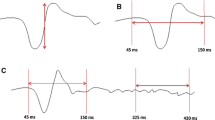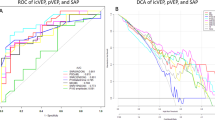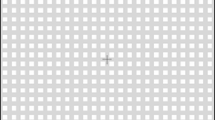Abstract
Twenty-one eyes of thirteen patients suffering from optic neuritis were examined with the Octopus automated perimeter and pattern visually evoked cortical potentials. All eyes had visual acuity of 0.2 or better. Visual field examination was measured by program 31 or 33, which tests the central 30-degree fields in a 6-degree grid. Pattern evoked potentials were obtained by reverse checkerboard stimulation of 3 rev/sec. A prolonged P100 latency was related to at least one abnormal point in the central nine points of program 31. All seven eyes with one abnormal point in the center had a delayed peak latency. The patients with either the normal central nine points of program 31 or normal peak latency had visual acuity of 0.6 or better. The graphs of visual acuity by Octopus compared with pattern evoked potential were very similar. With program Delta, the sensitivity loss ratio, i.e., the ratio of the mean loss at eccentricity of less than 10 degrees over less than 30 degrees, was related to the peak latency in optic neuritis caused by multiple sclerosis.
Similar content being viewed by others
References
Halliday AM, McDonald WI, Mushin J. Delayed visual evoked response in optic neuritis. Lancet 1972; 1: 982–5.
Kakisu Y, Adachi-Usami E, Mizota A. Pattern VECPs in optic neuritis caused by multiple sclerosis. Acta Soc Ophthalmol Jpn 1987; 91: 230–4.
Toyonaga N, Kakisu Y, Adachi E. Pattern disappearance visually evoked cortical potential in the diseases of visual pathway. Doc Ophthalmol 1986; 63: 23–9.
Ellenberger C, Jr, Ziegler SB. Quantitative perimetry and visual evoked potentials in multiple sclerosis. Doc Ophthal Proc Series 1977; 14: 203–6.
Van Dalen JTW, Spekreijse H, Greve EL. Visual field (VF) versus visual evoked cortical potential (VECP) in multiple sclerosis patients. Doc Ophthalmol Proc Series 1981; 26: 79–83.
Ohnuma T, Tagami Y, Isayama Y. Visual fields versus visual evoked potentials in optic nerve disorders. In: Greve EL, Heijl A., eds. Fifth International Visual Field Symposium. The Hague: W. Junk, 1983: 239–44.
Meienberg O, Flammer J, Ludin HP. Subclinical visual field defects in multiple sclerosis. J Neurol 1982; 227: 125–33.
Younge BR. Computer-assisted perimetry in visual pathway disease: neuro-ophthalmic applications. Trans Am Ophthalmol Soc 1984; 82: 899–942.
Wildberger H. Neuropathies of the optic nerve and visual evoked potentials with special reference to color vision and differential light threshold measured with the computer perimeter Octopus. Doc Ophthalmol 1984; 58: 147–227.
Author information
Authors and Affiliations
Rights and permissions
About this article
Cite this article
Fujimoto, N., Adachi-Usami, E. Comparison of automated perimetry and pattern visually evoked cortical potentials in optic neuritis. Doc Ophthalmol 69, 263–269 (1988). https://doi.org/10.1007/BF00154407
Issue Date:
DOI: https://doi.org/10.1007/BF00154407




